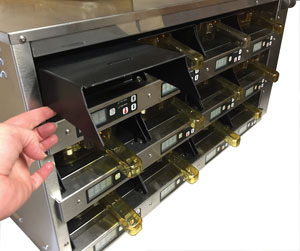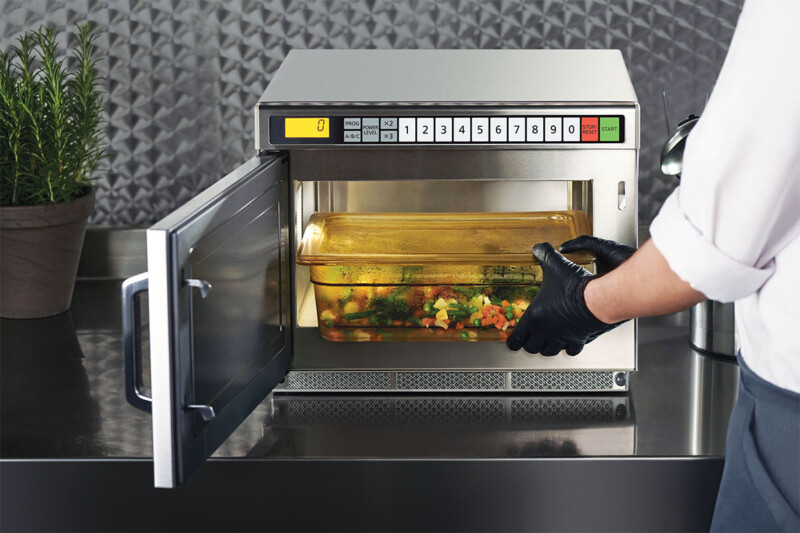Some Assembly Required

Cooking ingredients is only one step in preparing your kitchen’s menu choices. Employees still need to gather and assemble those prepared items into the final sandwich, plated dish or other offering. Visual modular holding cabinets are an ideal heated holding resource for fast-food, fast-casual, school and university, and healthcare kitchens doing high volumes in limited spaces.
Rather than full-size holding cabinets, modular cabinets are smaller and designed for countertop use, either in the kitchen or, in the case of operations with drive-thru windows, below or near the windows themselves. By holding a variety of ingredients, these cabinets keep employees from having to leave the station to get components from larger holding cabinets elsewhere. The number of individual modules in a single unit generally ranges from two to 12, depending on the maker. Using multiple units raises the number for even more variety.
All About Modular
Being modular, these cabinets lend themselves to holding a variety of foods in a central location. Cooked foods, typically held in 1/3 -size plastic holding pans with handles, stay hot and within easy reach for employees to grab what’s needed where they stand. Some models use ½ – and full-size pans, but 1/3-size pans (about 6 ¾ -in. W x 12 ½ -in. D x 2 ½ -in. H) are the most common size.
Most pans are made of dishwasher-safe, amber-colored plastic and are generally interchangeable with modular holding cabinets from all makers. Stainless pans are available, too, but plastic pans are the “visual” versions, letting you see what’s inside each compartment with out pulling the pan out and losing heat.
The modular aspect of the entire cabinet (vs. individual bins within cabinets) gives you all sorts of flexibility in terms of placement and countertop usage. Units are often stackable, taking up a single footprint on crowded countertops for holding a number of unique ingredients. Units also fit side-by-side where space allows.
One manufacturer cites a U-shaped modular layout just below a quick-service drive-thru window: on each side of the window, four stacked modules bookend two stacks of two modules, giving the employee easy access to a dozen ingredients in heated holding pans. Pass-thru modules bring two-sided flexibility to busy kitchens. Be sure, however, to stock pans with handles on both sides. While makers offer dedicated pass-thru modules, at least one manufacturer allows you to simply take the back panel off of your one-way module, opening it up for pass-thru use.
Heating Up
Foods that hold well in modular cabinets include a variety of pre-cooked proteins, such as hamburger patties, chicken, sausages and eggs. Biscuits, taco bowls and other non-protein items store well, too. French fries hold well in units designed to keep fried foods crisp, but there are other and better holding options made specifically for large volumes of fries.
Heating systems vary by model and manufacturer, but there are three basic types of heat available: conduction, radiant and convection. Conduction heats pans (then food) from below; it uses physical contact to transfer heat. Radiant heat transfers heat from above the pans (and doesn’t rely on direct contact), and convection heat flows through the holding spaces (typically fan-based). Some makers use a combination of heat types.
Typically, makers recommend conduction heat from the bottom for juicy ingredients, radiant heat for crispy foods and convection heat for the crispiest results. In general, holding temperatures range from 140°F-270°F. One manufacturer offers conductive heaters that go up to 195°F, radiant heaters that heat up to 250°F, and convective heat with a maximum of 225°F.
Another maker recommends holding crispy fried foods at 225°F, juicy proteins at temps between 190°F-200°F and such items as cookies, biscuits and pancakes at lower settings, but none below 150°F to ensure food safety.
Crispy foods typically keep warm on stainless trivets, generally interchangeable between same-size pans from any manufacturer. They allow convection heat to circulate completely around crispy foods and allow fat and other juices to drain into the pan under the trivet.
Stainless lids are a useful option for juicy grilled foods, locking in moisture and preventing air circulation.
Programming Cabinets
The modular aspect of these holding cabinets means, in many cases, each bin is programmable to hold at its own temperature. Some basic models hold the same temperature for all bins, but more expensive models allow for individual holding temps for unique items.
Some models have manual controls in the control panel of the unit, usually placed below the stacked modules. At least one maker places these controls on the side of the unit.
More expensive models let you program each module from a central computer, save those instructions on a flash drive and insert the drive into a USB port on the unit’s base. One manufacturer allows you to store up to 25 settings for each pan in one-degree increments and timers programmable for up to 99 min. for each pan. Alphanumeric displays show both temp and remaining time.
With other models, you can add pictures to the display for additional easy identification of what’s in each pan.
For operations with multiple locations, set your controls from a central computer and email them to all of your kitchens; modules in every location will operate and display consistently throughout.
Whether manually updated or programmed chainwide through computer software, temps and times can be easily adjusted. For those new to using modular holding cabinets, a spokesperson suggests getting starting point temps and times from the manufacturer. Since not all chicken nuggets or beef patties are made the same way, you may need to tweak the settings, but the ease of programming makes this a simple process.
At least one manufacturer is developing a combination of Wi-Fi and radio frequency identification that will communicate how long a food item has been held in a larger holding cabinet in the kitchen and will relay that to the modular unit when the food gets transferred, keeping track of total holding time for each ingredient.
RELATED CONTENT
- Advertisement -
- Advertisement -
- Advertisement -
TRENDING NOW
- Advertisement -
- Advertisement -
- Advertisement -


